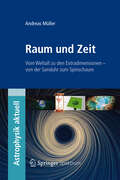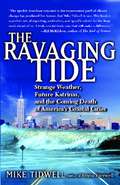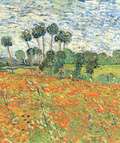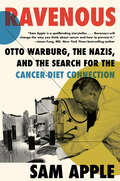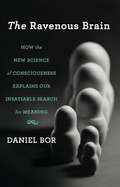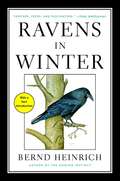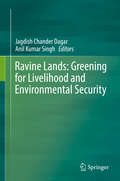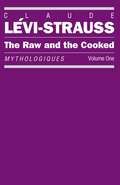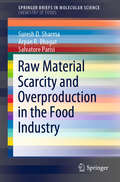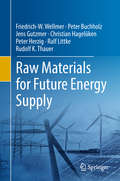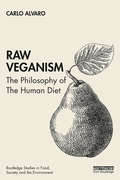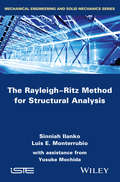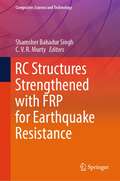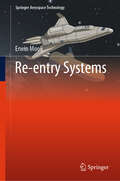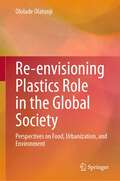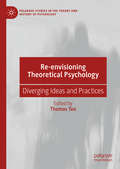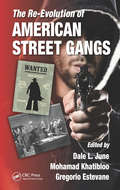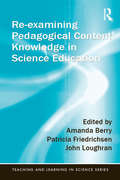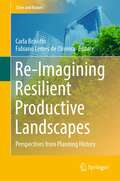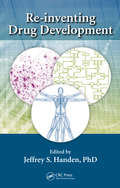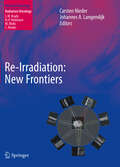- Table View
- List View
Raum-Akustik und Lärm-Minderung: Konzepte mit innovativen Schallabsorbern und -dämpfern (VDI-Buch)
by Helmut V. FuchsDie 4. Auflage dieses inzwischen als Standardwerk anerkannten Fachbuchs greift wieder aktuelle Probleme bei der Gestaltung von Raum-Akustik, Freifeld-Pr#65533;fst#65533;nden und Kanal-Auskleidungen auf. Zu deren nachhaltiger L#65533;sung werden Materialien und Bauteile sowie Auslegungskonzepte nach neuestem Stand des Wissens allgemein verst#65533;ndlich dargestellt. Aufbauend auf den Grundlagen wird das Konzept vertieft. Mehr als 100 Fallbeispiele zeigen, welche konstruktiven und baulichen Ma#65533;nahmen schnell und kosteng#65533;nstig zum Ziel f#65533;hren k#65533;nnen. Akustiker in der Praxis und Forschung sowie entwerfende und planende Architekten, Bauingenieure und Haustechniker finden neben den Grundlagen und Konzepten besonders auf f#65533;r bisher vernachl#65533;ssigten Bereich der tiefen Frequenzen wichtige Hinweise. In Darstellung und L#65533;sung akuter schalltechnischer Probleme stellt der Autor auch neue Erkenntnisse und Konzepte zur Verf#65533;gung, bei denen stets das praktisch N#65533;tzliche im Vordergrund steht. F#65533;r die eingef#65533;hrten Normen werden Probleml#65533;sungen ebenso behandelt wie die Grenzen der Anwendung, wo weiterf#65533;hrende L#65533;sungen gesucht werden. F#65533;r L#65533;rmprobleme in Arbeits- und Freizeit-R#65533;umen liefert das Buch eine F#65533;lle konstruktiver Anregungen.
Raum und Zeit
by Andreas MüllerRaum und Zeit sind die große Bühne, auf der sich unser Leben und alle irdischen und kosmischen Vorgänge abspielen. Meist erleben wir Raum und Zeit als unveränderlich und unbeeinflussbar. Doch Raum und Zeit könnten Eigenschaften haben, von denen selbst Einstein nicht zu träumen wagte. Andreas Müller erläutert unser modernes und höchst faszinierendes naturwissenschaftliches Weltbild und stellt das erfolgreiche Konzept der Raumzeit vor, das vor gut hundert Jahren von Albert Einstein begründet wurde. Darüber hinaus führt er den Leser bis zu den spannendsten Fragen der Gegenwart: Gibt es mehr als drei Raumdimensionen? Sind Raum und Zeit grundsätzlich in endliche, minimale Stücke zerhackt? Werden Raum und Zeit ewig existieren? Und welche Schlussfolgerungen über die Natur von Raum und Zeit müssen wir vor dem Hintergrund moderner Forschung ziehen?
Raum und Zeit: Vom Weltall zu den Extradimensionen - von der Sanduhr zum Spinschaum (Astrophysik aktuell)
by Andreas MüllerRaum und Zeit sind die große Bühne, auf der sich unser Leben und alle irdischen und kosmischen Vorgänge abspielen. Meist erleben wir Raum und Zeit als unveränderlich und unbeeinflussbar. Doch Raum und Zeit könnten Eigenschaften haben, von denen selbst Einstein nicht zu träumen wagte. Andreas Müller erläutert unser modernes und höchst faszinierendes naturwissenschaftliches Weltbild und stellt das erfolgreiche Konzept der Raumzeit vor, das vor gut hundert Jahren von Albert Einstein begründet wurde. Darüber hinaus führt er den Leser bis zu den spannendsten Fragen der Gegenwart: Gibt es mehr als drei Raumdimensionen? Sind Raum und Zeit grundsätzlich in endliche, minimale Stücke zerhackt? Werden Raum und Zeit ewig existieren? Und welche Schlussfolgerungen über die Natur von Raum und Zeit müssen wir vor dem Hintergrund moderner Forschung ziehen?
The Ravaging Tide: Strange Weather, Future Katrinas, and the Coming Death of America's Coastal Cities
by Mike TidwellIf, like many Americans, you believe the ongoing tragedy of Hurricane Katrina was a once-in-a-lifetime fluke, you need to read this book. In the coming years and decades, the safety of your region, your town, your home may depend on the warnings you'll encounter on these pages. That's because the exact same conditions that created the Katrina catastrophe and destroyed New Orleans are being replicated right now along virtually every inch of U. S. coastline. In The Ravaging Tide, Mike Tidwell, a renowned advocate for the environment and an award-winning journalist, issues a call to arms and confronts us with some unsettling facts. Consider: In the next seventy-five years, much of the Florida peninsula could lie under ocean water. So could much of Lower Manhattan, including all of the hallowed ground zero area. Major hurricanes like Katrina, scientists say, are becoming much more frequent and more powerful. Glacier National Park in Montana will have to change its name, as it is rapidly losing all of its thirty-five remaining glaciers. The snows atop Mt. Kilimanjaro in Africa, so memorably evoked in the Hemingway story, have already disappeared. The fault, Tidwell argues, lies mostly with the U. S. government and the energy choices it has encouraged Americans to make over the decades. Those policies are now actively bringing rising seas and gigantic hurricanes -- the lethal forces that killed the Big Easy -- crashing into every coastal city in the country and indeed the world. The Bush administration's own reports and studies (some of which it has tried to suppress) explicitly predict more intense storms and up to three feet of sea-level rise by 2100 due to planetary warming. The danger is clear: Whether the land sinks three feet per century (as in New Orleans over the past 100 years) or sea levels rise three feet per century (as in the rest of the world over the next 100 years), the resulting calamity is the same. Although Mike Tidwell sounds the clarion in The Ravaging Tide, this is ultimately an optimistic book, one that offers a clear path to a healthier and safer world for us and our descendants. He writes of trend-setting U. S. states like New York and California that are actively cutting greenhouse gases. And he heeds his own words: In one delightful personal chapter, he takes us on a tour of his suburban Washington, D.C., home and demonstrates how he and many of his neighbors have weaned themselves from the fossil-fuel lifestyle. Even when the government is slow to change, there are steps we as families can take to, yes, change the world.
Raven Biology of Plants (Eighth Edition)
by Ray F. Evert Susan E. EichhornLong acclaimed as the definitive introductory botany text, Raven Biology of Plants, Eighth Edition by Ray Evert, Susan Eichhorn, stands as the most significant revision in the book’s history. Every topic was updated with information obtained from the most recent primary literature, making the book valuable for both students and professionals
Ravenous: Otto Warburg, The Nazis, And The Search For The Cancer-diet Connection
by Sam AppleThe extraordinary story of the Nazi-era scientific genius who discovered how cancer cells eat—and what it means for how we should. The Nobel laureate Otto Warburg—a cousin of the famous finance Warburgs—was widely regarded in his day as one of the most important biochemists of the twentieth century, a man whose research was integral to humanity’s understanding of cancer. He was also among the most despised figures in Nazi Germany. As a Jewish homosexual living openly with his male partner, Warburg represented all that the Third Reich abhorred. Yet Hitler and his top advisors dreaded cancer, and protected Warburg in the hope that he could cure it. In Ravenous, Sam Apple reclaims Otto Warburg as a forgotten, morally compromised genius who pursued cancer single-mindedly even as Europe disintegrated around him. While the vast majority of Jewish scientists fled Germany in the anxious years leading up to World War II, Warburg remained in Berlin, working under the watchful eye of the dictatorship. With the Nazis goose-stepping their way across Europe, systematically rounding up and murdering millions of Jews, Warburg awoke each morning in an elegant, antiques-filled home and rode horses with his partner, Jacob Heiss, before delving into his research at the Kaiser Wilhelm Society. Hitler and other Nazi leaders, Apple shows, were deeply troubled by skyrocketing cancer rates across the Western world, viewing cancer as an existential threat akin to Judaism or homosexuality. Ironically, they viewed Warburg as Germany’s best chance of survival. Setting Warburg’s work against an absorbing history of cancer science, Apple follows him as he arrives at his central belief that cancer is a problem of metabolism. Though Warburg’s metabolic approach to cancer was considered groundbreaking, his work was soon eclipsed in the early postwar era, after the discovery of the structure of DNA set off a search for the genetic origins of cancer. Remarkably, Warburg’s theory has undergone a resurgence in our own time, as scientists have begun to investigate the dangers of sugar and the link between obesity and cancer, finding that the way we eat can influence how cancer cells take up nutrients and grow. Rooting his revelations in extensive archival research as well as dozens of interviews with today’s leading cancer authorities, Apple demonstrates how Warburg’s midcentury work may well hold the secret to why cancer became so common in the modern world and how we can reverse the trend. A tale of scientific discovery, personal peril, and the race to end a disastrous disease, Ravenous would be the stuff of the most inventive fiction were it not, in fact, true.
The Ravenous Brain: How the New Science of Consciousness Explains Our Insatiable Search for Meaning
by Daniel BorConsciousness is our gateway to experience: it enables us to recognize Van Gogh's starry skies, be enraptured by Beethoven's Fifth, and stand in awe of a snowcapped mountain. Yet consciousness is subjective, personal, and famously difficult to examine: philosophers have for centuries declared this mental entity so mysterious as to be impenetrable to science. In The Ravenous Brain, neuroscientist Daniel Bor departs sharply from this historical view, and builds on the latest research to propose a new model for how consciousness works. Bor argues that this brain-based faculty evolved as an accelerated knowledge gathering tool. Consciousness is effectively an idea factory--that choice mental space dedicated to innovation, a key component of which is the discovery of deep structures within the contents of our awareness. This model explains our brains' ravenous appetite for information--and in particular, its constant search for patterns. Why, for instance, after all our physical needs have been met, do we recreationally solve crossword or Sudoku puzzles? Such behavior may appear biologically wasteful, but, according to Bor, this search for structure can yield immense evolutionary benefits--it led our ancestors to discover fire and farming, pushed modern society to forge ahead in science and technology, and guides each one of us to understand and control the world around us. But the sheer innovative power of human consciousness carries with it the heavy cost of mental fragility. Bor discusses the medical implications of his theory of consciousness, and what it means for the origins and treatment of psychiatric ailments, including attention-deficit disorder, schizophrenia, manic depression, and autism. All mental illnesses, he argues, can be reformulated as disorders of consciousness--a perspective that opens up new avenues of treatment for alleviating mental suffering. A controversial view of consciousness, The Ravenous Brain links cognition to creativity in an ingenious solution to one of science's biggest mysteries.
Ravens in Winter
by Bernd Heinrich"One of the most interesting discoveries I've seen in animal sociobiology in years." --E.O. WilsonWhy do ravens, generally understood to be solitary creatures, share food between each other during winter? On the surface, there didn't appear to be any biological or evolutionary imperative behind the raven's willingness to share. The more Bernd Heinrich observed their habits, the more odd the bird's behavior became. What started as mere curiosity turned into an impassioned research project, and Ravens In Winter, the first research of its kind, explores the fascinating biological puzzle of the raven's rather unconventional social habits. "Bernd Heinrich is no ordinary biologist. He's the sort who combines formidable scientific rigor with a sense of irony and an unslaked, boyish enthusiasm for his subject, and who even at his current professorial age seems to do a lot of tree climbing in the line of research." --David Quammen, The New York Timesroject, and Ravens In Winter, the first research of its kind, explores the fascinating biological puzzle of the raven's rather unconventional social habits.
Ravine Lands: Greening for Livelihood and Environmental Security
by Anil Kumar Singh Jagdish Chander DagarThis book, the only one of its kind on ravine lands, reflects the significant advances made over the past two decades in our understanding of gully erosion, its controlling factors, and various aspects of gully erosion. It also addresses central research gaps and unanswered questions, which include historical studies on gully erosion to better understand the different stages of their formation; appropriate measuring techniques for monitoring or assessing the geological and hydrological parameters and processes involved in gully development; interaction of hydrological and other soil degradation processes; ecology and biodiversity of fragile ravines; impact of climate and environmental changes on soil erosion processes; development of effective and reliable gully erosion models; effective gully prevention and control measures; watershed-based management options; and ravine rehabilitation policies. The present book is a highly timely publication and deals with various aspects of ravine ecology and rehabilitation of degraded lands, particularly with the aid of biological approaches. As such, it offers a valuable guide for all scientists working in the fields of soil conservation / rehabilitation and agroforestry, students, environmentalists, educationists, and policymakers. More importantly, it focuses on the rehabilitation of one of the world’s most degraded and fragile ecosystems, ensuring the livelihoods of resource-poor farmers and landless families living in harsh ecologies that are more vulnerable to climate change.
The Raw and the Cooked: Introduction to a Science of Mythology Volume 1
by Claude Levi-Strauss John Weightman Doreen WeightmanThe book starts out making an analogy between music and myth. A piece of music is only music when it has one or more motifs which repeat and vary in structured ways. So avant-garde atonal serial music is not music. Myth works exactly the same way; recurring motifs hold a story together. The motif itself is not meaningful, as only the patterning and arrangement of motifs in the composition of the music/myth gives the work significance. The notes of a song played on an instrument do not have meaning the same way that spoken words strung together in a sentence have meaning. But these instrumental or mythic performances do have meanings and comprise ideas. Claude Levi-Strauss' work is translated by Doreen and John Weightman. It adds yet another chapter to the tireless quest for a scientifically accurate, esthetically viable, and philosophically relevant cultural anthropology.
Raw Material Scarcity and Overproduction in the Food Industry (SpringerBriefs in Molecular Science)
by Suresh D. Sharma Arpan R. Bhagat Salvatore ParisiThis book describes the consequences of an increased demand for food for human consumption for the global food industry. In four concise chapters, the authors explore the trend for the overproduction of food, the concomitant diminution of raw materials and the increase in environmental concerns. Chapter one describes the variations in biochemical properties of fishmeal depending on the season and geographical location. Chapter two discusses how the expansion of cropland and pastures to meet the rising demand for food is damaging the environment, while chapter three examines the impact of bee viruses on food crops and production. Lastly, the fourth chapter addresses the issue of food adulteration and provides specific examples of fraud in the American dairy industry. This book is of interest to researchers working in the area of food production in academia and industry, as well as certification and scientific bodies involved in food inspection.
Raw Materials for Future Energy Supply
by Friedrich-W. Wellmer Peter Buchholz Jens Gutzmer Christian Hagelüken Peter Herzig Ralf Littke Rudolf K. ThauerThis is the first book that analyses the future raw materials supply from the demand side of a society that chiefly relies on renewable energies, which is of great significance for us all. It addresses primary and secondary resources and substitution, not only from technical but also socioeconomic and ethical points of view.The “Energiewende” (Energy Transition) will change our consumption of natural resources significantly. When in future our energy requirements will be covered mostly by wind, solar power and biomass, we will need less coal, oil and natural gas. However, the consumption of minerals, especially metallic resources, will increase to build wind generators, solar panels or energy storage facilities. Besides e.g. copper, nickel or cobalt, rare earth elements and other high-tech elements will be increasingly used. With regard to primary metals, Germany is 100 % import dependent; only secondary material is produced within Germany. Though sufficient geological primary resources exist worldwide, their availability on the market is crucial. The future supply of the market is dependent on the development of prices, the transparency of the market and the question of social and ethical standards in the raw materials industry, as well as the social license to operate, which especially applies to mining. The book offers a valuable resource for everyone interested in the future raw material supply of our way of life, which will involve more and more renewable energies.
Raw Veganism: The Philosophy of The Human Diet (Routledge Studies in Food, Society and the Environment)
by Carlo AlvaroHuman beings are getting fatter and sicker. As we question what we eat and why we eat it, this book argues that living well involves consuming a raw vegan diet. With eating healthfully and eating ethically being simpler said than done, this book argues that the best solution to health, environmental, and ethical problems concerning animals is raw veganism—the human diet. The human diet is what humans are naturally designed to eat, and that is, a raw vegan diet of fruit, tender leafy greens, and occasionally nuts and seeds. While veganism raises challenging questions over the ethics of consuming animal products, while also considering the environmental impact of the agriculture industry, raw veganism goes a step further and argues that consuming cooked food is also detrimental to our health and the environment. Cooking foods allows us to eat food that is not otherwise fit for human consumption and in an age that promotes eating foods in ‘moderation’ and having ‘balanced’ diets, this raises the question of why we are eating foods that should only be consumed in moderation at all, as moderation clearly implies they aren’t good for us. In addition, from an environmental perspective, the use of stoves, ovens and microwaves for cooking contributes significantly to energy consumption and cooking in general generates excessive waste of food and resources. Thus, this book maintains that living well and living a noble life, that is, good physical and moral health, requires consuming a raw vegan diet. Exploring the scientific and philosophical aspects of raw veganism, this novel book is essential reading for all interested in promoting ethical, healthful, and sustainable diets.
Ray Tracing and Beyond
by E. R. Tracy Aptara. IncThis complete introduction to the use of modern ray tracing techniques in plasma physics describes the powerful mathematical methods generally applicable to vector wave equations in non-uniform media, and clearly demonstrates the application of these methods to simplify and solve important problems in plasma wave theory. Key analytical concepts are carefully introduced as needed, encouraging the development of a visual intuition for the underlying methodology, with more advanced mathematical concepts succinctly explained in the appendices, and supporting Matlab and Raycon code available online. Covering variational principles, covariant formulations, caustics, tunnelling, mode conversion, weak dissipation, wave emission from coherent sources, incoherent wave fields, and collective wave absorption and emission, all within an accessible framework using standard plasma physics notation, this is an invaluable resource for graduate students and researchers in plasma physics.
The Rayleigh-Ritz Method for Structural Analysis
by Luis Monterrubio Sinniah Ilanko Yusuke MochidaA presentation of the theory behind the Rayleigh-Ritz (R-R) method, as well as a discussion of the choice of admissible functions and the use of penalty methods, including recent developments such as using negative inertia and bi-penalty terms. While presenting the mathematical basis of the R-R method, the authors also give simple explanations and analogies to make it easier to understand. Examples include calculation of natural frequencies and critical loads of structures and structural components, such as beams, plates, shells and solids. MATLAB codes for some common problems are also supplied.
Ray's Big Day: A Journey at the Speed of Light
by Josh LewisFollow one little ray of light as she embarks on an exciting journey through the solar system and beyond!When Ray launches from the sun into outer space, she knows she's destined for adventure. But who knew everything in space was so far apart? Can Ray unlock her creativity to pass the time and make something new?With a lovable protagonist and engaging comic illustrations, Ray's Big Day tackles the vastness of space through one ray of light's optimistic exploration. Ray's journey makes basic information about the solar system, the universe, and the speed of light accessible and engaging for kids. Fun and educational backmatter illustrates how far and fast light travels through our solar system.Perfect for readers of Stacy McAnulty's Earth! My First 4.54 Billion Years.
RC Structures Strengthened with FRP for Earthquake Resistance (Composites Science and Technology)
by Shamsher Bahadur Singh C. V. R. MurtyThis book covers the merits and demerits of advanced composite materials with regard to their applications for earthquake-resistant applications. The chapters in the book are divided into the following main topics: (a) the processing and fabrication of fiber-reinforced polymer composite materials, (b) the mechanical characteristics of materials, (c) the design of strengthening and reinforcing systems for earthquake resistance of the deficient structural system, and (d) design of new earthquake-resistant structures using advanced composite materials. The chapters present experimental tests and numerical modeling of responses of various kinds of structural elements for predicting the load versus deflection response, energy absorption capacity, ductility index, energy ratios, failure modes, and load capacity. It also looks at different kinds of composite systems and their hybrid or functionally graded composites using advanced composite materials, such as carbon fiber-reinforced polymer (CFRP), glass fiber-reinforced polymer (GFRP), aramid fiber-reinforced polymer (AFRP), basalt fiber-reinforced polymer (BFRP), and natural fiber-reinforced polymer (NFRP). The results presented in this book will be of high interest to scientists, researchers, students, and engineers working in the fields of advanced composite materials such as FRPs and other forms of composites for seismic retrofitting and strengthening of deficient structures. This book is helpful for teachers and (undergraduate, Master, and Ph.D.) students to develop a fundamental understanding of the design of earthquake-resistant design of structures (such as buildings, bridges, and industrial structures) using lightweight, durable, and sustainable FRP materials.
Re-entry Systems (Springer Aerospace Technology)
by Erwin MooijThis book explains and describes re-entry systems for both the Earth and other planets. It provides sufficient information for readers to perform entry mission analysis for different bodies in the Solar System. Not only does it discuss re-entry flight mechanics, but also addresses relevant subsystems and fields, enabling readers to put the information into perspective. The book begins with a complete description of planetary environments, including atmosphere, gravity fields and the shape of the primary body. After a detailed discussion of planar flight mechanics, it then moves on to discuss guidance, navigation, and control, entry, descent, and landing systems, as well as thermal protection systems. It uses examples throughout the text, enabling the theory to be linked to practical applications. Ideal for those wanting an updated, thorough discussion of re-entry systems, this book is suitable for students and researchers.
Re-envisioning Plastics Role in the Global Society: Perspectives on Food, Urbanization, and Environment
by Ololade OlatunjiThis book covers the challenges and opportunities presented by plastics in the modern era and sheds light on the complex interplay of technology, environment, and socio-economic dynamics. With a thorough exploration of the history, uses, and potential of plastics, the book reviews the impact of plastics beyond single-use plastics, and critiques multiple long-term plastic applications that are significant for food security, water resource management, ecological conservation/restoration, and sustainable urbanization. It also explores frameworks for achieving a more sustainable plastic economy aligned with sustainable development goals. This book comprises 13 chapters, commencing with a critical assessment of plastics in the context of sustainable development and global society. It proceeds with a historical overview of plastics' evolution, showcasing pivotal milestones and innovations in modern industry and daily life. Subsequent chapters delve into diverse topics: the intricate relationships between plastics, food security, and sustainable urbanization; plastics' impact on water safety, management, distribution, and conservation; their potential as an alternative energy source; and their innovative applications in sustainable transportation and energy generation. Emphasis is placed on plastics' role in waste reduction and recycling, as well as the latest sustainable alternatives like biodegradable and recyclable materials. In the book's final sections, readers will learn about green buildings and climate-resilient cities constructed using innovative plastic materials, and plastics' significance in space exploration. The book concludes with a forward-looking perspective on plastics' future, accompanied by recommendations for a more sustainable coexistence between society and these versatile materials. This book is a valuable resource for researchers, policymakers, industry professionals, and concerned citizens seeking to navigate the intricate landscape of plastics, their environmental implications, and their potential for sustainable development.
Re-envisioning Theoretical Psychology: Diverging Ideas and Practices (Palgrave Studies in the Theory and History of Psychology)
by Thomas TeoThis volume presents a re-envisioning of the field of theoretical psychology and offers unique visions for its present and future from leaders of North American philosophical psychology. It contends that theoretical psychology has reached ‘middle-age’ and must consider new directions to renew its growth. Rooted in a range of research traditions and the intellectual biographies of its authors, it paves the way toward this necessary revitalization of the content, activities, responsibilities, and hopes of theoretical psychology. The authors situate their analyses in the context of the increasing gap between alternative and mainstream and between the discipline and the profession of psychology. They demonstrate that changes in society, culture and technology, the internationalization of the psychological humanities, and the cross-fertilization of intellectual innovations from other disciplines now afford possibilities for new orientations in theoretical psychology. The volume aims to do justice to psychological topics, human beings, and the intellectual problems that psychologists encounter, while also providing space for (meta)theoretical engagement, often neglected in the discipline. Together, the chapters in this collection make the case that a renewal of the discipline and practice of psychology is a task that is best accomplished collectively, and, despite significant disagreements, in solidarity.
The Re-Evolution of American Street Gangs
by Dale L. June Mohamad Khatibloo Gregorio EstevaneThe problem of gangs and gang subculture is a growing threat to the stability of neighborhoods and entire communities. During the past two decades, gang members have increasingly migrated from large urban centers to suburban areas and other countries. This book addresses the intricacies and diversities of street gangs, drawing on the expertise of h
Re-examining Pedagogical Content Knowledge in Science Education (Teaching and Learning in Science Series)
by Amanda Berry John Loughran Patricia FriedrichsenPedagogical Content Knowledge (PCK) has been adapted, adopted, and taken up in a diversity of ways in science education since the concept was introduced in the mid-1980s. Now that it is so well embedded within the language of teaching and learning, research and knowledge about the construct needs to be more useable and applicable to the work of science teachers, especially so in these times when standards and other measures are being used to define their knowledge, skills, and abilities. Re-examining Pedagogical Content Knowledge in Science Education is organized around three themes: Re-examining PCK: Issues, ideas and development; Research developments and trajectories; Emerging themes in PCK research. Featuring the most up-to-date work from leading PCK scholars in science education across the globe, this volume maps where PCK has been, where it is going, and how it now informs and enhances knowledge of science teachers’ professional knowledge. It illustrates how the PCK research agenda has developed and can make a difference to teachers’ practice and students’ learning of science.
Re-Imagining Resilient Productive Landscapes: Perspectives from Planning History (Cities and Nature)
by Carla Brisotto Fabiano Lemes de OliveiraThis book explores how lessons from past urban planning experiences can inform current debates on urban agriculture. Productive landscapes today have been posited as instruments for the positive transformation related to territorial fragility and abandonment, promoting social cohesion, food security and wider environmental and economic benefits. The book will re-map the way in which seeming landscape limitations and challenges can be turned into potential, innovation and a new lease of urban-rural life. It does so by drawing on significant past urban agricultural experiences in planning as vectors for new critical reflections relevant to re-igniting ideas for future envisioning of urban scenarios in which productive landscapes play fundamental transformative roles. The focus is on planning ideas and the roles of key individual planners, all of which have designed agricultural strategies for the city at some point in their careers. It intends to help us today reimagine urban-rural relationships, and the transformation of under or mis-used urban open spaces, peri-urban areas, fringe conditions and in-between spaces.
Re-inventing Drug Development
by Jeffrey S. HandenThe biopharmaceutical industry has entered an era of unprecedented change and challenge, characterized by increasing pricing pressures, rising rates of attrition in the product development lifecycle, and decreasing scientific innovation. The most successful products are losing patent protection, and pipelines have been unable to fill the gap. This
Re-irradiation: New Frontiers
by Carsten Nieder Johannes LangendijkNew developments such as refined combined modality approaches and significant technical advances in radiation treatment planning and delivery are facilitating the re-irradiation of previously exposed volumes. As a consequence, both palliative and curative approaches can be pursued at various disease sites. Re-irradiation: New Frontiers is the first book to provide a comprehensive overview on current re-irradiation strategies. Re-irradiation methods, technical aspects, the role of combined therapy with anticancer drugs and hyperthermia, and normal tissue tolerance are all discussed in detail. In addition, disease-specific chapters document recent clinical results and future research directions. Professionals involved in radiation treatment planning and multimodal oncology treatment will find this book to be an invaluable aid in understanding the benefits and limitations of re-irradiation and in designing prospective trials.

